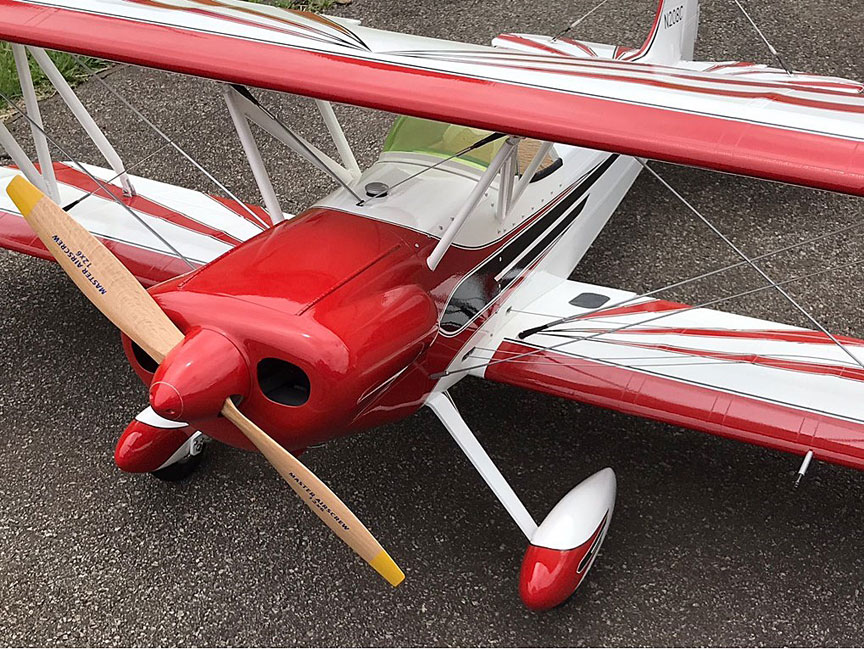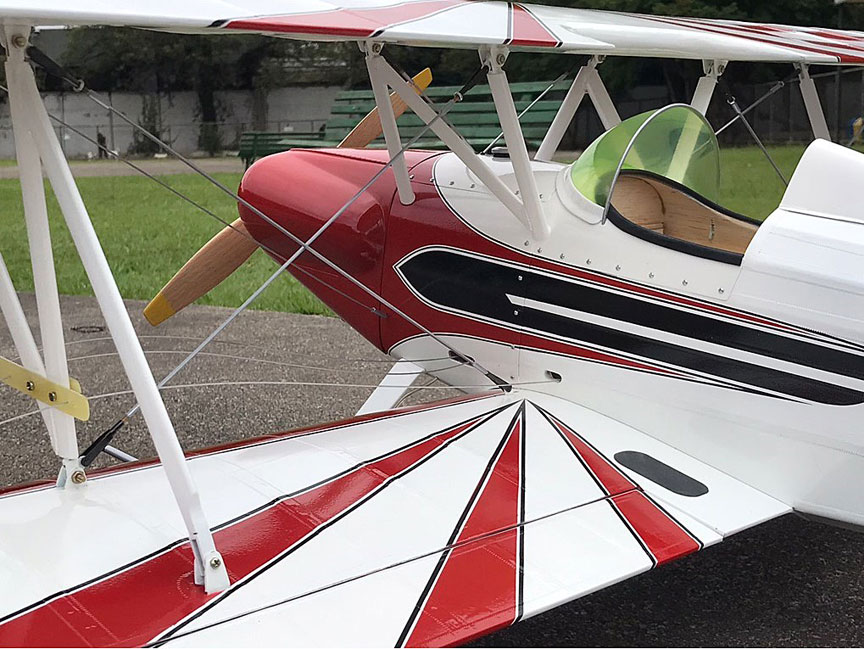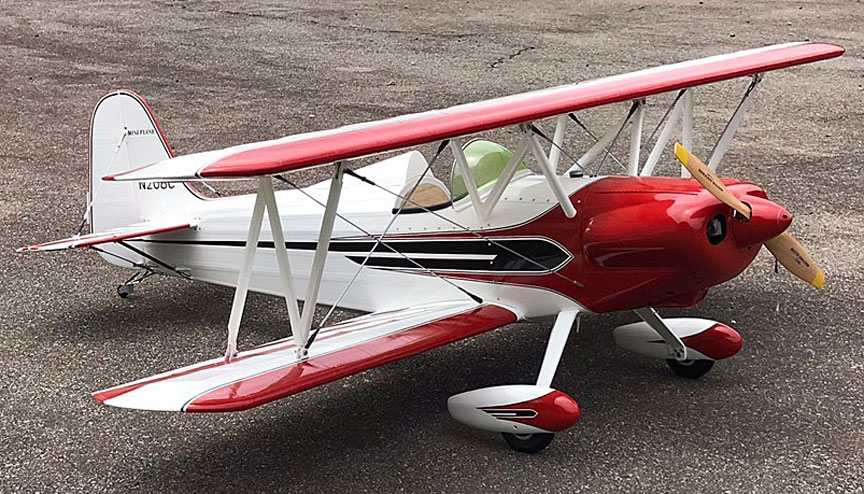Frederico Cesquim of São Paulo, Brazil, built this Smith Miniplane from a Sig kit in 84 days in order to have a plane for the 2021 Brazilian Scale nationals. All photos by Fred Cesquim.
From kit to Brazilian F4B Nats 2021 in 84 days
By Fred Cesquim
On Aug. 26, 2021, after two years of postponed Brazilian Scale Nats because of Covid restrictions, I was informed that the competition would be within 90 days. I am the F4B Brazilian manager and had a scratch-built Aeronca L on works for two years but realized that the 90 days would be a tight schedule to finish her, and I was missing some crucial parts to be imported, so this one was off limits for the Nats.
That was bad news. I HAD to show up with a plane, as we are struggling to bring more competitors back to CL Scale and I had no chance to be out of the competition. A few weeks before I had purchased an old SIG Smith Miniplane radio control kit and decided to build it for the competition, very simple and basic, all Monokote just to be present and encourage other flyers to show up.
Usually, a competitive F4B model takes about two to three years to build (my schedule), but a simple Monokoted model could be done within 90 days with dedication and focus. Next step was choosing the real model to be duplicated and gather documentation. I came across this beautiful 1963 plane N-208C Nebraska-USA owned by Justin Morris. I was caught by the striking painting and the elegant wheel pants, very different from the SIG kit. To be honest, I never liked the SIG model, but the N-208C has class and beauty.
Then problems started to pile up. Kit supplied wheel pants, cowl and canopy that are supposed to make my life easy are so different from the chosen plane that I had to fabricate new ones, and while I was doing that step toward fidelity, I made a new tail group exactly as the real with a lot less area (about 25%), added the belly and fuselage diamond shaped sides rather than the kit´s flat area.
By this time the “keep it simple” plan went bananas, and I was caught in the “scale mud” so no more Monokoting and welcome Oratex, painting and why not rib stitchings? Found out that the LA46 could be completely concealed within the cowl and since I raised the notch on the model finish opted to go for F4B full regalia adding a three-line J-Roberts system (which was a first to me). While working nonstop daily when my webstore allowed and full time on weekends the wood frame was going fast and molds for fiberglass parts being done alongside during glue setting of the wings. Had a brief vacation of six days with my wife and while visting a hobby shop in Rio de Janeiro bought some fittings that I needed and was having hard time to find in Brazil.
About this, here´s an information: Our country has an import policy that taxes everything on 80% and, import time on customs is about 30-60 days, so finding material is a hard task as most shops have little or no stock of non-ordinary model supplies due to high cost and low demand, even Oratex is impossible to find and I was lucky to be gifted from a friend.

What started out as a Sig RC kit ended up as the third-place finisher in Brazil's Scale Nats after an 84-day rush of construction.
On Nov. 18 under drizzling rain, I shot the clear coat (I don´t have a paint booth, so I had to shoot outdoors under a small shed, but with the competition four days ahead I had no choice.) Next day I worked until 2:40 p.m. and Saturday morning went for the field for the maiden flight. The day was windy, so much that if I wasn´t competing next day I would give up flying but I had to test the plane and learn the three-cable system and adjust the engine settings and controls. As soon as the plane took off things went south: pointed toward skies on a 70 degrees step and when I tried to level it started a horse back ride. On my physical and mental burnout, I overlooked the CG proper setting. I loosely checked, noticed a tail-heavy model, but thought it was manageable in flight. I couldn´t be more mistaken. I was frantic running back to stretch cables while trying to maintain level flight; those who have flown control line tail heavy know the feeling. After some desperate laps I managed to make it straight but the wing was so high that every time it faced wind it came back to the up and down struggle. While calming down I was experimenting with throttle control figuring out how to land it in one piece, but every time the speed bled off, the plane went mad again. Sensing that the fuel was close to the end, I had no choice but to put her back even if needed to plummet her and destroy landing gear. When the engine was idle and plane descending, wind got her and threw her toward me at the center. The plane went inverted with a heavy slack on the cables. I started to run as much as I could but felt the plane was lost, then it finished a loop and hit the grown spinner/wheel pant/bottom wing tip and flipped over. After recovering from the struggle, I went to see the damaged, and found out it was far from a total loss. At this point I decided I would not compete but that I had done my best to finish the plane in such a short time and driving back home thought to CA things back just to show at the NATS next day and try to be an inspiration for other modelers. While putting things back, I decided that I would fly her after adding weight to the nose, after all. I would have to test fly her anytime later, so, I still had a chance at the competition. What I missed to finish on Saturday afternoon was to add the pilot. Instead I spent the time fixing the crash.
Monday woke up at 5 a.m. and made the long drive to the field. A friend of mine helped to set the CG properly and I found that it was off about 1.1/12 behind! Added a lot of weight to the nose and proceeded to the static judging. The three judges where astonished to learn that I have done that plane in such a short time and that crashed the day before. Next was the flight, and I admit I was a lot anxious and nervous, but had no chance to step back, as soon as the plane took off, after some taxi training with the three-line system the flight was stable, and I was practicing the throttle and checking plane behavior. Worked smooth but plane pulled a lot due to final weight. Landing was good and taxied to the judges' spot, earning some relief and happy claps from modelers. Next flight, knowing what to expect, I put a better flight show with good taxi, lazy eights, level laps, overshoot, touch and go, and a slow flyby (needed both hands to cope with weight!). Landed, taxied back and that was it, I had made it against all odds.
The competition was a breakthrough for Brazilian standards with the biggest attendance of flyers on the last 30 years, so I was happy and relieved. My final score was third place, due to the lack of the pilot figure, by FAI rules, if you miss any pilot, even a cartoon cut on the shape of a pilot, you have a 10% note reduction. If I had had time to add the pilot I would have got the first place given static and flight score, both higher than the other competitors; they had great planes and put some awesome flights and earned the placing. In retrospect I was lucky to be there. When the plane passed over my head, I was sure I had lost her for good, so next year I’ll be back with a well-rehearsed flight pattern and with a PILOT sitting there pretty.

After a crash on its first test flight, Fred repaired the plane in time to make it to the Nats. The repairs took up the time he planned for installation of the pilot, a detail that dropped the plane to third place in the competition.
See photos of the Smith Miniplane construction project
Flying Lines home page
Back to Scale main page
This page was upated April 22, 2022

